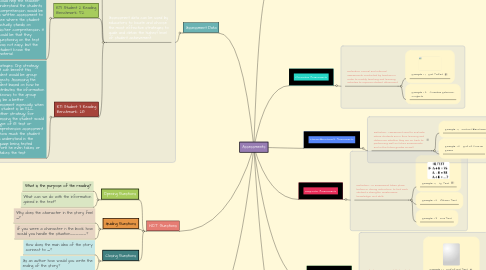
1. H.O.T. Questions
1.1. Opening Questions
1.1.1. What is the purpose of the reading?
1.1.2. What can we do with the information gained in the text?
1.2. Guiding Questions
1.2.1. Why does the character in the story feel _____?
1.2.2. If you were a character n the book how would you handle the situation______?
1.3. Closing Questions
1.3.1. How does the main idea of the story connect to _____?
1.3.2. As an author how would you write the ending of the story?
2. Assessment Data
2.1. Assessment data can be used by educators to locate and choose the most effective strategies to guide and obtain the highest level of student achievement.
2.1.1. RTI Student 1 Reading Benchmark: 44
2.1.1.1. Strategies: One strategy that can be used to support the student would be working in small groups and completing an exit ticket at the end of every session. Another strategy for student support would be an end-ofunit re-test to check the students understanding.
2.1.2. RTI Student 2 Reading Benchmark: 52
2.1.2.1. Strategies: One strategy to better support this student would be the benchmark re-testing after small group instruction on content. Another strategy that could help the teacher understand the students comprehension would be a written assessment to see where the student actually stands on his/her comprehension, it could be that they questioning on the test was not easy, but the student know the material.
2.1.3. RTI Student 3 Reading Benchmark: 28
2.1.3.1. Strategies: One strategy that can benefit this student would be group projects. Assessing the student based on how he contributes the information he knows to the group may be a better assessment especially when the student is an ELL. Another strategy for assessing the student would a type of IQ test or comprehension assessment on how much the student can understand in the language being tested before he even takes or re-takes the test
3. Assessments are forms of measure that allow students to demonstrate their understanding and comprehension of specific content to their educators and all those that have access to their scores.
4. Formative Assessments
4.1. Definition: Formal and informal assessments conducted by teachers in order to modify teaching and learning activities to improve student attainment
4.1.1. Example #1 - Exit Ticket
4.1.2. Example #2 - Creative Extension Projects
5. Diagnostic Assessments
5.1. Definition: An assessment taken place before or during instruction, to find each student's strengths, weaknesses, knowledge, and skills
5.1.1. Example #1 - I.Q. Test
5.1.2. Example #2 - Fitness Test
5.1.3. Example #3 - Pre-Test
6. Performance Assessments
6.1. Definition: A form of testing that requires students to perform a task rather than select an answer from a multiple choice list
6.1.1. Example #1 - Written Assessments
6.1.2. Example #2 - Group Projects
7. Interim/Benchmark Assessments
7.1. Definition: Assessment used to evaluate where students are in their learning and determine whether they are on track to performing well on future assessments and in the future grades as well
7.1.1. Example #1 - District Benchmark
7.1.2. Example #2 - End of Course Exams
8. Summative Assessments
8.1. Definition: Assessment that evaluates student learning at the end of a unit by comparing it against a certain standard
8.1.1. Example #1 - End-of-unit Test
8.1.2. Example #2 - Standardized Test
